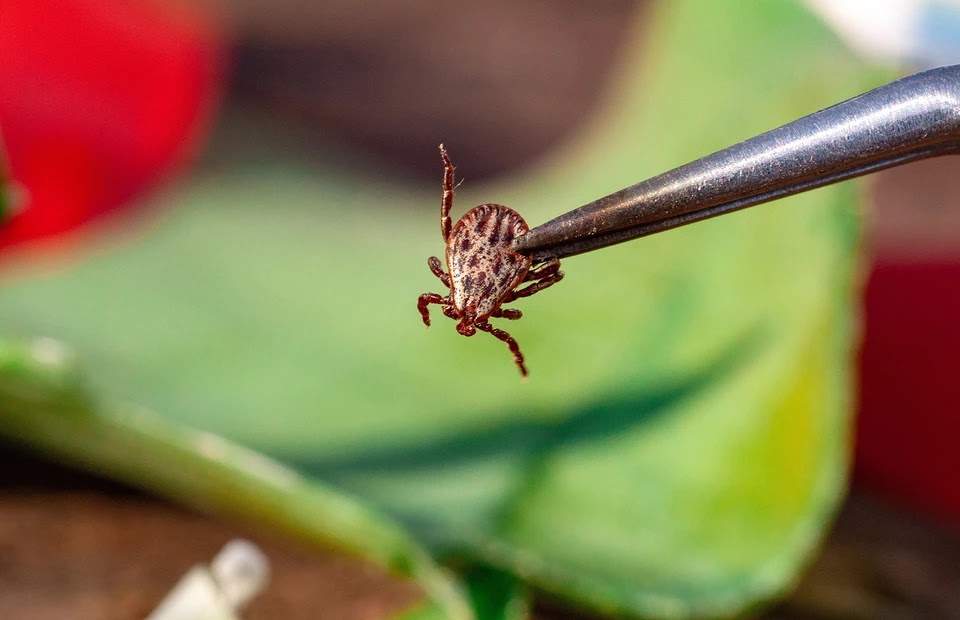Ticks are very active in summer. The risk of picking them up after a walk in nature is quite high.
In recent years, the number of ticks has increased in Russia. They are most aggressive in clear weather in the morning from 8 am to 12 pm, in the evening from 4 pm to 7 pm; in cloudy weather - all day. Why are parasites dangerous? Teatthat can cause serious illnesses - encephalitis and Lyme disease( borreliosis ).
It's hard to be suspicious. The initial symptoms of these infections are nonspecific, reminiscent of the common cold: lethargy, headache, fever. However, with untimely diagnosis and treatment of these infections, severe disorders of the cardiovascular and nervous systems, skin, and eyes can develop.
notice in time
After a walk in nature, carefully examine yourself. The favorite places of the tick on the human body are the back, neck, legs, skin behind the ears, armpits, groin.
The parasite drunk with blood looks like a red wart or a mole the size of a small pea. You should be alerted that it suddenly grew on the skin: a couple of days ago there was nothing like this - it suddenly appeared from somewhere. You can not pick off such a formation, otherwise the head of the tick will remain in your skin. This place will become inflamed, a wound that does not heal for a long time is formed.
How to be? Contact the nearest emergency room or clinic (address can be clarified by calling 103). If there is no way to quickly get to the doctor, try to remove the bloodsucker yourself at home.
Before the procedure, wash your hands with soap and water, put on gloves (rubber, latex or use a regular plastic bag - this will protect the skin if you accidentally crush the bloodsucker). Disinfect the bite site and tools: it’s good if you have tweezers from a manicure set (preferably with thin tips) or a twister at hand. A twister is a tool that does not allow you to squeeze the parasite (unlike tweezers), which means that the risk of infection is significantly reduced. Externally, the device looks like a mini-nail clipper or a fork with two curved prongs (sold in pharmacies and supermarkets).
How to get a tick out...
...thread
Make a loop of thread. Gently throw it between the abdomen and head, tighten. Then tighten the thread while twisting it. Pull the tick out by slowly swinging and pulling up the thread.
... with tweezers
Try to capture the tick with tweezers as close as possible to the place to which he stuck. Hold the tweezers perpendicular to the bite surface. Rotate the body around the axis and gently pull up. Do not pull out, do not pull the parasite, otherwise the trunk will remain in the wound.
... twister
Position the tool so that the tick is between two teeth, then slowly rotate the handle around the axis (you can turn it both clockwise and counterclockwise) until you get the bloodsucker.
... with a syringe
It is better to take a syringe with a capacity of 2 cm3. Cut off the upper part (where the needle is usually attached) - it is important to make the cut even. Moisten the skin around the bite with water. Firmly attach the syringe to the affected area, pull the plunger up. It is more difficult to remove the tick in this way, so it is less preferable.
If the proboscis came off
Carefully inspect the bite site. If you notice a black dot, this means that the head or proboscis remained in the skin. Sterilize the needle. Pull out the head in the same way as a regular splinter .Then lubricate the wound with alcohol, chlorhexidine or iodine.Wash your hands with soap afterwards.
How to remove a tick from a child ? Just like in adults. It doesn't matter where he stuck - on the head, stomach or thigh.
What to do next
Place the tick in a jar with a damp disk, close the lid tightly, and refrigerate. You can store it for 1-2 days (it simply won't survive anymore). Therefore, contact your doctor as soon as possible. The tick will be sent to the district sanitary and epidemiological surveillance laboratory to find out if it is infected with the encephalitis virus (affects the defeat of the gray matter of the brain / meninges of the brain or spinal cord or Borrelia spirochete, causing Lyme disease. If the fears are confirmed, then in the first case it will be necessary to administer antiviral gamma globulin, and in the second - to take a course of antibiotics.
Common Mistakes
- Do not take the tick with your bare hands, do not crush it. If there are micro-damages on the skin on the fingers, bacteria or viruses can enter the bloodstream and lead to infection.
- Do not touch your eyes, mouth and nose with your hands after removing the parasite, so as not to infect the mucous membranes.
- Do not jerk sharply with tweezers or thread, otherwise you will tear off the abdomen, and the proboscis or head will remain under the skin.
- Do not burn the parasite with a match - it is unlikely that it will come out, and you can get burned.
- Do not lubricate the bite site with kerosene, cream, alcohol, oil, toothpaste. Firstly, you will lose time while you wait for the parasite to get out under the influence of these drugs. Secondly, they may not affect him in any way. Thirdly, it can inject toxins under the skin that contain the infection.
At the doctor's appointment
If you notice these symptoms after the bite, hurry to the clinic.
- There was a slight redness at the site of the bite. After a few days, it increased (while its center brightens) and gradually became like a red ring - typical for borreliosis.
- Flu-like symptoms appeared: fever, chills, weakness, headache , sore throat or joints. So borreliosis or encephalitis can manifest itself.
How to prevent a bite
- Are you going to nature? Choose light-colored clothes. It makes it easier to spot insects. T-shirts, shorts, sandals for hiking in the forest are not the best option. A long-sleeve blouse or a windbreaker, trousers, sneakers is what you need. Put on a cap or scarf on your head.
- Use repellents. Treat clothes, shoes, backpacks with them before going to potentially dangerous areas.
- After returning from a walk, take off your clothes, examine yourself, take a shower.
- If you took a dog with you to nature , do not forget to examine it too: ticks cling to animals more often than to people.
- Small bloodsuckers can enter an apartment with a bouquet of wild flowers or in a basket of berries. Therefore, everything that you brought from the forest, carefully sort it out.
- The best way to protect against viral encephalitis is to get vaccinated. There are domestic and imported vaccines. Please note: the vaccine consists of two injections given 2 months apart. You can go on forest walks only 2 weeks after the second injection, when immunity is developed. There is no vaccination against borreliosis yet.






0 Comments